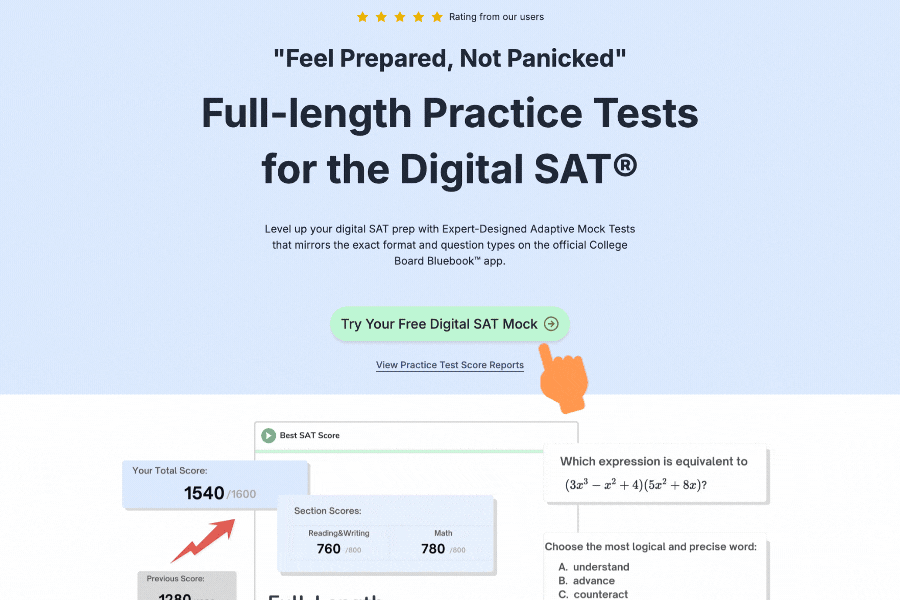To master "Command of Evidence (Textual)", you'll encounter two distinct types of evidence. Each requires a different analytical approach.
🔬 Scientific Evidence
Features:
- Presents a hypothesis from science/social science research.
- Requires interpreting experimental outcomes or data.
- No prior knowledge needed-all clues are in the passage.
How to Approach:
- Identify the hypothesis/claim (often words like "suggests," "proposes," or "hypothesizes").
- Predict what result would support or weaken it.
- Match the answer choice to that prediction.
Example Passages Expecting Scientific Evidence
➥ Passage 1 (Environmental Science)
Researchers studying urban heat islands hypothesized that increasing tree canopy cover would reduce daytime temperatures by at least 2°C. To test this, they collected thermal data over five summers, comparing shaded parks with nearby paved neighborhoods. While tree-covered areas were consistently cooler, the temperature difference averaged only 1.1°C and never surpassed 1.3°C—far less than predicted. These results suggest that factors like heat-absorbing asphalt, building density, and limited airflow may outweigh the cooling effects of trees alone. The team now recommends combining urban greening with reflective infrastructure (e.g., cool roofs) to address extreme heat more effectively.
Direct Main Claim:
"...hypothesized that increasing tree canopy cover would reduce daytime temperatures by at least 2°C."
➥ Passage 2 (Psychology)
A 2023 study examined how multitasking impacts retention during lectures. Students watched an educational video under two conditions: one group exchanged text messages, while another took handwritten notes. Contrary to expectations, the texting group performed nearly identically to focused listeners on subsequent recall tests, accurately remembering key facts. This outcome challenges long-held assumptions about cognitive load, suggesting that brief digital interruptions may not significantly disrupt learning—at least for simple recall tasks. However, deeper comprehension metrics (e.g., concept application) were not assessed. Researchers speculate that younger generations' adaptability to digital stimuli could explain these results, though further replication is needed to rule out variables like video engagement levels or texting frequency.
Implied Main Claim:
"Brief digital interruptions (like texting) during learning may not significantly impair simple recall of facts, contradicting assumptions about cognitive load."
Key Evidence Supporting the Claim:
- The texting group performed "nearly identically" to focused listeners on recall tests.
- Results challenge "long-held assumptions about cognitive load."
- Note: The claim is cautiously framed: it specifies simple recall (not deep comprehension) and acknowledges need for further research.
📚 Literary Evidence
Features:
- Analyzes a claim about a literary work (novel, poem, etc.).
- Answer choices are direct quotations from the text.
- Focuses on how quotes illustrate the argument.
How to Approach:
- Pinpoint the central argument (e.g., "The poem critiques industrialization").
- Evaluate quotations for direct relevance to that argument.
- Eliminate options that are off-topic or vague.
Example Passages Expecting Literary Evidence
➥ Passage 1 (Poetry Analysis)
The poem's common interpretation as a triumph of individualism oversimplifies Frost's intent. While the finale ("I took the one less traveled by") suggests pride in uniqueness, earlier details undermine this reading: the paths "equally lay" in identical leaves, and the speaker admits the choice was arbitrary. Frost's own commentary confirms this deliberate ambiguity-his "sigh" implies retrospective doubt, not certainty. The true tension lies in how memory reshapes decisions, not in the roads themselves.
Direct Main Claim:
"...common interpretation as a triumph of individualism oversimplifies Frost's intent."
➥ Passage 2 (Novel Analysis)
Critics frequently contend that Emily Brontë's Wuthering Heights frames love as inherently destructive, pointing to Heathcliff and Catherine's volatile dynamic. Their obsession drives cycles of vengeance and self-imposed exile, harming even innocent bystanders. However, the novel complicates this view through moments of spiritual unity, such as Catherine's famous claim “I am Heathcliff”-a fusion of identities that seems to defy earthly consequences. The moorland setting, with its untamed storms and blurred boundaries, mirrors this tension between ruin and rapture. While their love undeniably causes suffering, Brontë leaves open whether its primal intensity ultimately condemns or elevates the soul.
Implied Main Claim:
"While Brontë's Wuthering Heights depicts love as destructive through Heathcliff and Catherine's toxic obsession, it simultaneously suggests their bond transcends conventional morality—creating unresolved tension between ruin and spiritual union."
Key Evidence Supporting the Claim:
- Show Destruction: Their relationship "fuels vengeance and self-imposed exile"; Harms "innocent bystanders" (e.g., Isabella, Hareton).
- Show Transcendence: Catherine's "I am Heathcliff" as identity fusion; Moorland imagery mirrors "blurred boundaries" between love/ruin.
